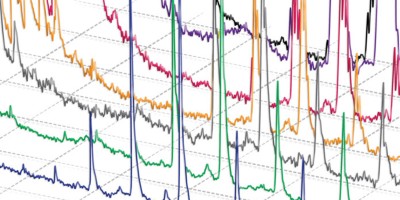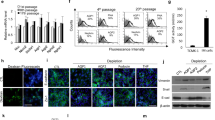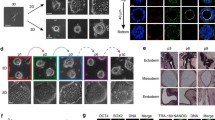Abstract
We have developed a novel 3D cell culture model that uses mouse inner-medullary collecting duct (mIMCD3) cells to generate epithelial spheroids. This model is amenable to efficient siRNA knockdown and subsequent rescue with human patient-derived alleles. Spheroids develop apicobasal polarity and complete lumens, and they are consequently an ideal model for polarity defects seen in renal ciliopathies such as nephronophthisis. Briefly, mIMCD3 cells are transfected and subsequently passaged to a Matrigel mixture, which is seeded in chamber slides and covered in growth medium. Once the spheroids are formed, Matrigel is dissolved and immunocytochemistry is performed in the chamber slides. The technique is amenable to semiautomatic imaging analysis, and it can test multiple genes simultaneously, gene-dosing effects and a variety of therapeutic interventions. The spheroid technique is a unique and simple 6-d in vitro method of interrogating ex vivo tissue organization.



Similar content being viewed by others
References
Tobin, J.L. & Beales, P.L. The nonmotile ciliopathies. Genet. Med. 11, 386–402 (2009).
Hildebrandt, F., Benzing, T. & Katsanis, N. Ciliopathies. N. Engl. J. Med. 364, 1533–1543 (2011).
Renkema, K.Y., Stokman, M.F., Giles, R.H. & Knoers, N.V. Next-generation sequencing for research and diagnostics in kidney disease. Nat. Rev. Nephrol. 10, 433–444 (2014).
Stokman, G., Qin, Y., Racz, Z., Hamar, P. & Price, L.S. Application of siRNA in targeting protein expression in kidney disease. Adv. Drug Deliv. Rev. 62, 1378–1389 (2010).
Pampaloni, F., Reynaud, E.G. & Stelzer, E.H. The third dimension bridges the gap between cell culture and live tissue. Nat. Rev. Mol. Cell Biol. 8, 839–845 (2007).
O'Brien, L.E., Zegers, M.M. & Mostov, K.E. Opinion: building epithelial architecture: insights from three-dimensional culture models. Nat. Rev. Mol. Cell Biol. 3, 531–537 (2002).
Otto, E.A. et al. Candidate exome capture identifies mutation of SDCCAG8 as the cause of a retinal-renal ciliopathy. Nat. Genet. 42, 840–850 (2010).
Rauchman, M.I., Nigam, S.K., Delpire, E. & Gullans, S.R. An osmotically tolerant inner medullary collecting duct cell line from an SV40 transgenic mouse. Am. J. Physiol. 265, F416–F424 (1993).
Luijten, M.N. et al. Birt-Hogg-Dube syndrome is a novel ciliopathy. Hum. Mol. Genet. 22, 4383–4397 (2013).
Chaki, M. et al. Exome capture reveals ZNF423 and CEP164 mutations, linking renal ciliopathies to DNA damage response signaling. Cell 150, 533–548 (2012).
Choi, H.J. et al. NEK8 links the ATR-regulated replication stress response and S phase CDK activity to renal ciliopathies. Mol. Cell. 51, 423–439 (2013).
de Groot, T. et al. Lithium causes G2 arrest of renal principal cells. J. Am. Soc. Nephrol. 25, 501–510 (2014).
Ghosh, A.K., Hurd, T. & Hildebrandt, F. 3D spheroid defects in NPHP knockdown cells are rescued by the somatostatin receptor agonist octreotide. Am. J. Physiol. Renal. Physiol. 303, F1225–F1229 (2012).
Sang, L. et al. Mapping the NPHP-JBTS-MKS protein network reveals ciliopathy disease genes and pathways. Cell 145, 513–528 (2011).
Hynes, A.M. et al. Murine Joubert syndrome reveals Hedgehog signaling defects as a potential therapeutic target for nephronophthisis. Proc. Natl. Acad. Sci. USA 111, 9893–9898 (2014).
Chow, W.H. & Devesa, S.S. Contemporary epidemiology of renal cell cancer. Cancer J. 14, 288–301 (2008).
Lilleby, W. & Fossa, S.D. Chemotherapy in metastatic renal cell cancer. World J. Urol. 23, 175–179 (2005).
Elia, N. & Lippincott-Schwartz, J. Culturing MDCK cells in three dimensions for analyzing intracellular dynamics. Curr. Protoc. Cell Biol. 43, 4.22.1–4.22.18 (2009).
Debnath, J. & Brugge, J.S. Modelling glandular epithelial cancers in three-dimensional cultures. Nat. Rev. Cancer. 5, 675–688 (2005).
Acknowledgements
We thank C.J. Westlake and L. Sang for their help in setting up the protocol, and M.A. Jewett for expert urological support. R.H.G. is supported by the Dutch Kidney Foundation grants CP11.18 (KOUNCIL) and 13A3D103, and EU FP7/2009 241955 (SYSCILIA) and 305608 (EURenOmics). H.A. is supported by the Anna-Liise Farquharson Kidney Cancer Research Fund, Princess Margaret Foundation, Toronto, Canada.
Author information
Authors and Affiliations
Contributions
R.H.G. and P.K.J. designed the protocol, which was independently validated by H.A. R.H.G. and H.A. drafted the manuscript.
Corresponding author
Ethics declarations
Competing interests
The authors declare no competing financial interests.
Supplementary information
Real-time movie of mIMCD3 cells in a spheroid transfected with somatostatin receptor 5-HTTP:GFP.
Cilia and basolateral membranes are green fluorescent. (MOV 2867 kb)
Rights and permissions
About this article
Cite this article
Giles, R., Ajzenberg, H. & Jackson, P. 3D spheroid model of mIMCD3 cells for studying ciliopathies and renal epithelial disorders. Nat Protoc 9, 2725–2731 (2014). https://doi.org/10.1038/nprot.2014.181
Published:
Issue Date:
DOI: https://doi.org/10.1038/nprot.2014.181
- Springer Nature Limited
This article is cited by
-
Development of an In Vitro Model for Inflammation Mediated Renal Toxicity Using 3D Renal Tubules and Co-Cultured Human Immune Cells
Tissue Engineering and Regenerative Medicine (2023)
-
Primary URECs: a source to better understand the pathology of renal tubular epithelia in pediatric hereditary cystic kidney diseases
Orphanet Journal of Rare Diseases (2022)
-
Primary cilia suppress Ripk3-mediated necroptosis
Cell Death Discovery (2022)
-
mTOR and S6K1 drive polycystic kidney by the control of Afadin-dependent oriented cell division
Nature Communications (2020)
-
Profiling of miRNAs and target genes related to cystogenesis in ADPKD mouse models
Scientific Reports (2017)





